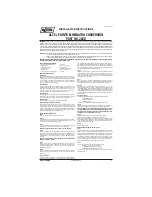
REVERSE (R): Use this gear to back up.
Notice: Shifting to REVERSE (R) while your vehicle
is moving forward could damage the transaxle.
The repairs would not be covered by your warranty.
Shift to REVERSE (R) only after your vehicle is
stopped.
Also use this gear to rock your vehicle back and forth to
get out of snow, ice or sand without damaging your
transaxle. See If Your Vehicle is Stuck in Sand, Mud, Ice
or Snow on page 4-30 for additional information.
NEUTRAL (N): In this position, the engine does not
connect with the wheels. To restart when you are
already moving, use NEUTRAL (N) only. Also, use
NEUTRAL (N) when your vehicle is being towed.
{
CAUTION:
Shifting into a drive gear while your engine is
running at high speed is dangerous. Unless
your foot is firmly on the brake pedal, your
vehicle could move very rapidly. You could
lose control and hit people or objects. Do not
shift into a drive gear while your engine is
running at high speed.
Notice: Shifting out of PARK (P) or NEUTRAL (N)
while the engine is running at high speed may
damage the transaxle. The repairs would not be
covered by your warranty. Be sure the engine is not
running at high speeds when shifting your vehicle.
AUTOMATIC OVERDRIVE (D): This position is for
normal driving. If you need more power for passing, and
you are:
•
Going less than 35 mph (55 km/h), push the
accelerator pedal about halfway down.
•
Going about 35 mph (55 km/h) or more, push the
accelerator all the way down.
The transaxle will shift down to the next gear and have
more power.
Notice: Driving your vehicle if you notice that it is
moving slowly or not shifting gears as you
increase speed may damage the transaxle. Have
your vehicle serviced right away. You can drive in
SECOND (2) when you are driving less than 35 mph
(55 km/h) and AUTOMATIC OVERDRIVE (D) for
higher speeds until then.
AUTOMATIC OVERDRIVE (D) can be used for towing.
You may want to shift the transaxle to THIRD (3) or,
if necessary, to a lower gear if the transaxle shifts
too often under heavy loads and/or hilly conditions.
See Towing a Trailer on page 4-38 for more information.
2-27
Summary of Contents for 2006 DTS
Page 5: ...These are some examples of symbols that may be found on the vehicle v...
Page 6: ...NOTES vi...
Page 18: ...Put someone on it Get it up to speed Then stop the vehicle The rider does not stop 1 12...
Page 133: ...NOTES 3 3...
Page 134: ...Instrument Panel Overview Column Shift Model shown Console Shift Model similar 3 4...
Page 256: ...NOTES 3 126...
Page 402: ...NOTES 5 102...
Page 434: ...NOTES 7 16...
















































